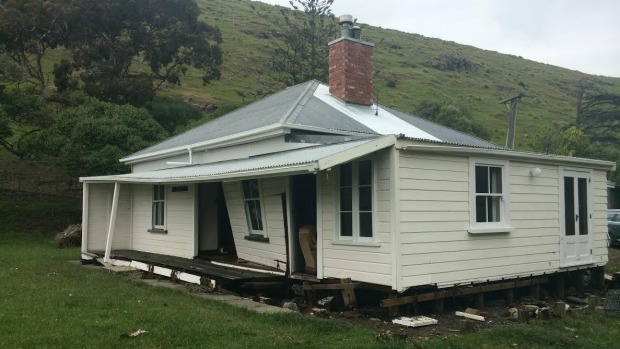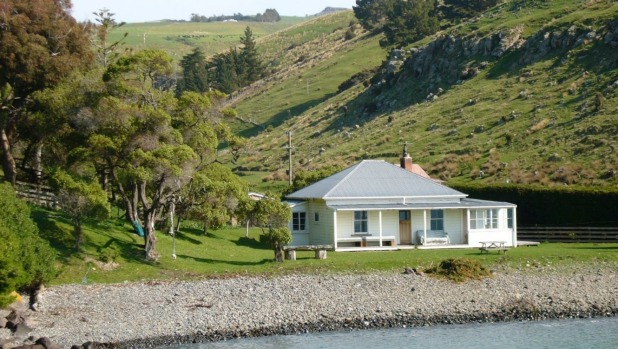Little Pigeon Bay cottage smashed by tsunami waves

The cottage after the tsunami knocked it off its piles and washed away the deck and verandah.
A five-metre high tsunami has destroyed a historic holiday cottage on Banks Peninsula.
Owners Edward and Penny Aitken checked their 100-year-old building at daylight following Monday morning's earthquakes and tsunami warning. They were shocked to find it pushed off its piles and smashed.
"It's had it, it's a write-off," Edward Aitken said.

The cottage at Little Pigeon Bay, pictured before the tsunami.
The cottage sits at the head of north-facing Little Pigeon Bay. It is the only home in the inlet.
The Aitkens live at next door Pigeon Bay and rent out the cottage as holiday accommodation. It was vacant at the time.
READ MORE
* Severe 7.5 quake in North Canterbury
* North Canterbury's historic Waiau pub gutted
.jpg)
Inside the damaged cottage, where the water struck almost two metres high.
Aitken said the waterline inside the house was nearly two metres high. They found logs and other debris on the property.
"The sheer huge force of the water demolished several of the walls and it's taken a deck and a verandah away.
"It's taken everything off its piles and demolished everything inside."
.jpg)
The force of the water picked up and tossed around furniture and appliances.
The missing deck was discovered further around the bay and the garden furniture was on the beach or washed out to sea.
Aitken said the water was at low tide when the tsunami hit, meaning the wave must have been about five metres high.
"It's just surged up Little Pigeon Bay, and dumped on the house. The bay is narrow and that would've made it so much worse.
"The alignment to Kaikoura [near the earthquake's epicentre] meant the surge would've just been funnelled up the bay."
Dr Emily Lane, a tsunami scientist at the National Institute of Water and Atmospheric Research (Niwa), said the theory made sense.
"Depending on the shape, a bay can funnel the water if it opens to the direction the wave came from.
"You get water sloshing around in a bay and running up and down.
"If the first wave is rolling out when the second one comes in, it can set up a resonance and that's when you get the big waves."
A 2012 Niwa study found the north coast of Banks Peninsula, including Lyttelton Harbour, was at risk of higher tsunami waves than other nearby coasts. The word tsunami means harbour wave in Japanese.
Aitken said their wrecked cottage was solidly built and suffered only minor damage in previous earthquakes. Part of their family farm, it was once occupied by his parents.
He said the damage was "a bit upsetting" but they had lodged an insurance claim and would rebuild.
In the meantime, they would contact upcoming guests to advise them to make new holiday plans. The popular cottage was fully booked most weekends and over the summer holidays.
Nearby luxury lodge Annandale, on the other side of Pigeon Bay, moved guests out of waterfront accommodation on Monday morning as a precaution.
Hospitality director Callum Farnell said all their buildings stayed high and dry, although water came across the road.
"It rolled in about 2am – we saw it coming up the harbour."
- Stuff
it was low tide at the time as per above.
A 0.5 meter wave wouldn't make it that high. Maybe a 5 meter wave would tho. Hmmm
The fridge wouldn't be on the veranda saying "what the hell is that coming down the bay..."
To see such damage, look at the damage created by just a significant rockfall in a fjord. The intensity and power that accumulates at node points (amplitude is additive, or subtractive, but power is RMS) is not unlike in Christchurch's case, like pebbles in a pond, but in a fixed vessel, like a narrow harbour, then the effect compounds - energy is preserved, in a rapidly ever decreasing volume. Think the opposite of the inverse square rule for the power of the wind for example.
"It rolled in at 2am'
And the tsunami siren sounded in the Sumner Redcliffs region AFTER that!!!
Zooming in on photo shows not the case.
Stuff reporter a little dramatic
It has a lower centre of gravity than the bigger items so didn't fall over.
OR the house owners might have absentmindedly up righted it before taking their photos.
5 metre from low tide mark.
If it had been high tide it would have been a different story